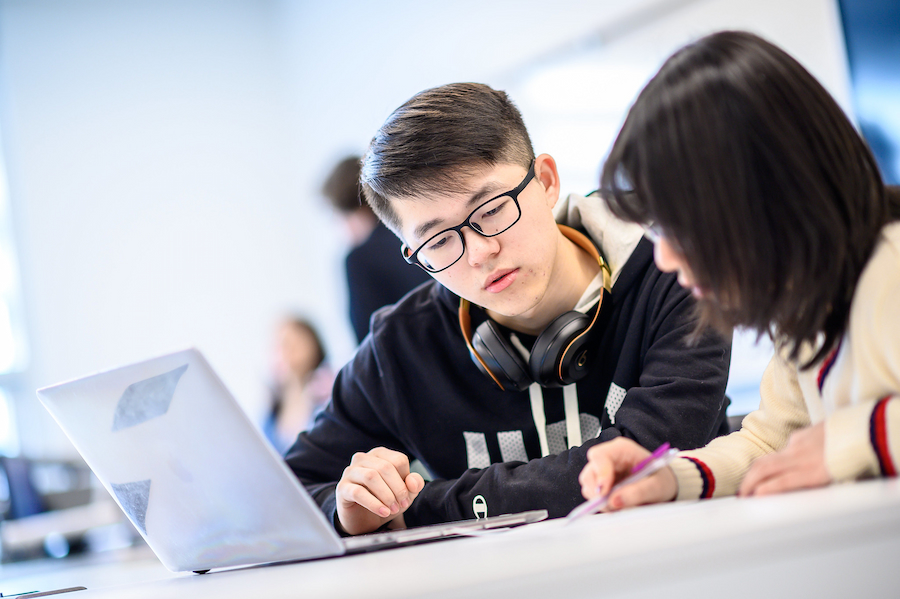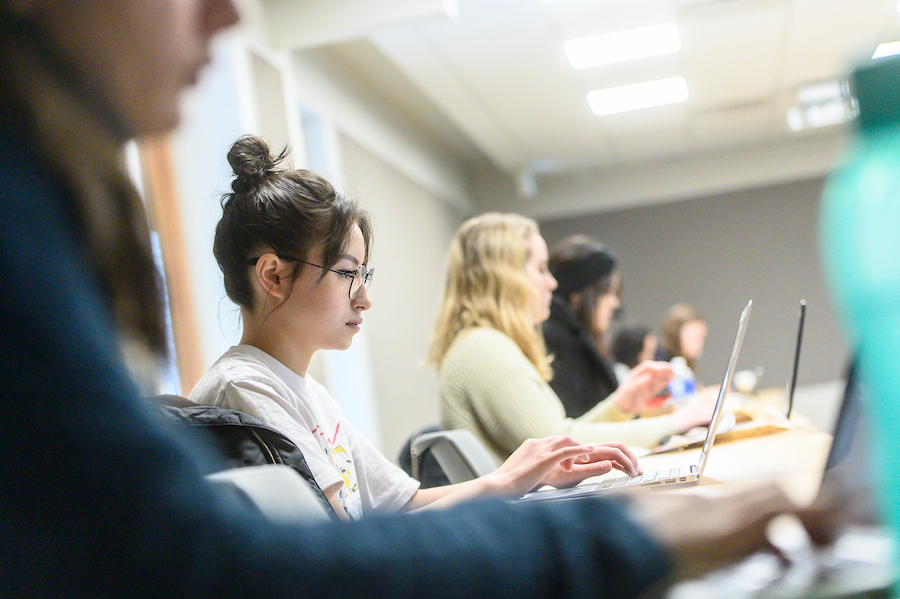
Reposted from: Centre for Teaching, Learning, and Technology
How the Department of Asian Studies transformed its undergraduate Chinese language program
Learning a foreign language is a great way to discover a different way to think, view and describe the world around us. But what is the point of studying if you cannot verbally interact with native speakers to know about their ways of thinking and doing, apart from what they eat or what holidays they celebrate?
Transforming and enriching student learning experiences via engagement in authentic settings is a UBC priority described in the “Shaping UBC’s next century” strategic plan through practical learning. In this context, the Department of Asian Studies decided to look into its community and beyond to include more interactions with native Mandarin speakers in its undergraduate programs — from local UBC and Vancouver communities, as well as from Mainland China and Taiwan. The goal: to bridge UBC, local and international communities’ efforts to help its 1,400 students learn the language differently.
An established Mandarin-speaking community as an ideal breeding ground for a community-based learning project
Ask people who have had the opportunity to travel to another country to learn another language, and they will often tell you that their learning improved much more once they had the chance to communicate verbally with native speakers in a real-life context. Luckily for UBC undergraduate Asian Languages students, they don’t need to go very far to enjoy a similar experience.
British Columbia has seen robust growth over the last decades in people speaking Asian languages as their first, including Punjabi, Cantonese, Mandarin and Tagalog to name a few. This influx of cultures, knowledge, and native speakers makes the province an ideal breeding ground for a language learning project rooted in the local community.

When Dr. Hsiang-Ning Sunnie Wang, associate professor of teaching at UBC’s Department of Asian Studies joined the program, she quickly saw the potential for her Chinese language courses. “After I came to UBC, I realized that both UBC and the Vancouver area are very unique because we can find abundant Chinese culture, resources and expertise here. That made me wonder, how can we bring in more of these local resources into the program?”
Sunnie, along with other instructors from the Department of Asian studies, designed a project that looked to improve student language confidence and performance, and to enhance their sense of community identity to make a stronger language program. By making students, especially undergraduates, part of these local communities, this practical learning project could provide a blueprint for how languages can be taught at UBC and beyond.
In 2019, the project received a three-year grant from the Teaching and Learning Enhancement Fund (TLEF). This support allowed Sunnie’s team to build a course model that shifted away from classroom-based teaching and learning, to community-based language learning (CBLL) and communication-focused pedagogy. “We realized that this could be an opportunity for Mandarin learners, the Department of Asian Studies and the local community to create a mutually beneficial situation that enriches our students’ learning experience,” she says. Once the project was approved, Sunnie and her team worked to implement changes from the model to improve the learning experience for students.
Using a practical and Community-Based Language Learning methodology
Before the start of this project, Chinese language programs – like many other programs – were primarily instructor-centered in a traditional way. “The instructor decided what students needed to learn, and focused primarily on textbook-based teaching and learning, without real opportunities of using the right language to interact with native speakers,” Sunnie remembers. “We would have lecture time, and, of course, we would offer students the opportunity to talk, because it’s a language course.”
However, this structure can prove rigid in some instances, and leave oral practice to a minimum. “If I have 30 students in my class and only 50 minutes, including my own speaking time, that leaves each student with one minute to talk, at most. That’s how we used to teach,” Sunnie explains. It was with the objective to increase the oral communication component in their courses that Sunnie and her team decided to explore a CBLL pedagogy.

By definition, CBLL is a method in which students work together – while being guided by an instructor or community member – to develop which aspects of the language they would like to learn. More importantly, this pedagogy helps new learners feel more comfortable by removing the barriers between instructors and learners, and creates an environment where oral communication takes a much bigger role. “We replaced the oral practice with official tutoring sessions,” Sunnie describes. “Now, on average, our students attend three hours of class each week, and one entire hour of oral tutoring.”
These tutoring sessions are at the core of the Department of Asian Studies CBLL pedagogy. The majority of Chinese language courses now have them, assisted by members of the UBC teaching and learning community, as well as by other Mandarin speakers from the local area, Mainland China and Taiwan. “During these sessions, we invite volunteers connected to UBC – because we have a lot of undergraduate Mandarin speakers – high school students, students from other local universities, seniors and even Chinese moms living in Vancouver. Technology makes it easy to connect remotely with them,” Sunnie adds.
The CBLL program also counts on a large number of teaching assistants helping out with these tutoring sessions, for whose willingness to help and enthusiasm Sunnie and her team are grateful. “We have so many undergraduate volunteers, but we also hire some of them. Thanks to the funding resources we received, such as the TLEF, we’re able to hire 45 teaching assistants and Work Learn students every semester. We also operate different training workshops to help them develop their professional skills and work ethic.”
Another way CBLL was implemented into the Chinese language courses is what Sunnie describes as a learning portfolio. Used instead of exams, these activities allow students to choose what interests them to build a project and, under clear guidance from instructors, present it in front of the class for evaluation and celebration with their classmates.
“We use task-based learning as evaluation. Chinese language courses don’t have any final or midterm exams anymore. Besides the learning outcomes, we want to encourage students to enjoy the learning process and focus on their individual and collective progress.”
– Dr. Sunnie Wang, Associate Professor of Teaching, UBC Department of Asian Studies
By having students engage with the local and international Mandarin-speaking community, CBLL creates an experience that is beneficial to all involved.
A mutually beneficial experience for students and the community
Three years into the project, Sunnie sees the impact CBLL has had on instructors and students, and how it created an even stronger language-learning method for the Department of Asian Studies in the process.
“I would say that CBLL is a change of teaching philosophy and pedagogy for instructors,” Sunnie confirms. “In the past, most of us focused primarily on textbook teaching: to explain the meaning of a word or describe a grammar pattern, ask students to read a textbook passage together, and use exams to evaluate students’ learning result. That is less the case now.”
In this sense, the role of instructors evolved through this CBLL project. They are no longer seen as the ultimate knowledge authority deciding what and how students should learn, but as facilitators of their students’ language learning experience. And as Sunnie explains, this change has had a noticeable impact on student performance, confidence, and behaviour in class.
“Students are very different in my courses now. In the past, they would get to the class and then leave right at the end of the session. But nowadays, I often have to remind them that the class is over, because they keep talking to one another! It doesn’t just benefit their learning experience, but also their social life, because it’s always fun to learn with friends. You don’t feel shy to make mistakes, and you want to support each other to succeed.”

All in all, the changes made to the program evaluation methods, the emphasis on oral practice and the larger impact of connecting with the community have contributed to create a program that favours learning and applying socially, culturally appropriate and authentic language instead of “textbook vocabulary and conversation.” The best part? Students are all in on this, as Sunnie confirms. “We don’t have to push them to learn anymore. They are doing it because they want to use the language to interact with real Mandarin-speaking people here at UBC, in British Columbia, and even outside Canada.”
Looking back at the project, Sunnie couldn’t help but reflect on how far the program has come, and how different her experience was when she learned English. “After studying for almost a decade, I remember that I didn’t have sufficient confidence and competence to talk to people in English. I knew how to read and write, but local manners and social interactions skills were still foreign to me.” Thus, she considers the CBLL pedagogy as a stepping stone for how language can be taught in the future.
“I want to bring the community into the classroom. Everything in our life or culture is example-based and feedback-centered, so why not our language courses?”
In the context of language learning, a CBLL pedagogy, combined with a practical learning approach, brings students closer to what the primary purpose of learning another language should be: the ability to communicate with the outside world first and foremost. “This is our little contribution to the UBC teaching and learning community, and something we hope we can inspire other programs to try.”